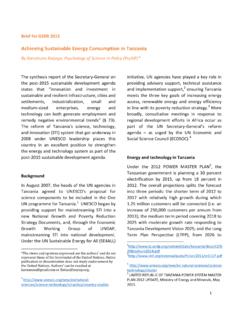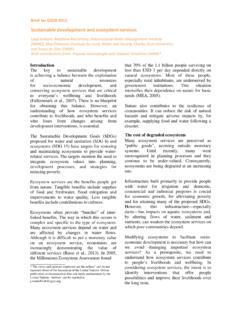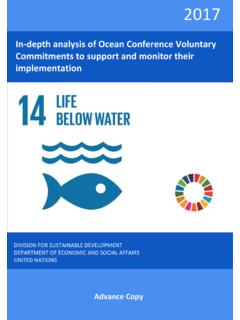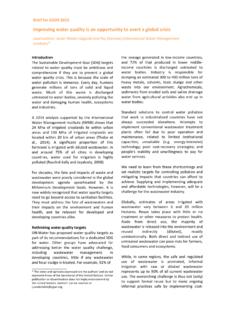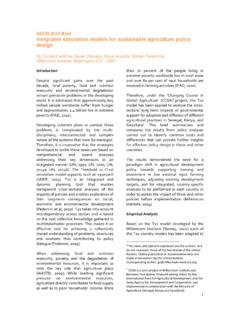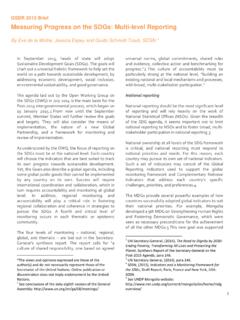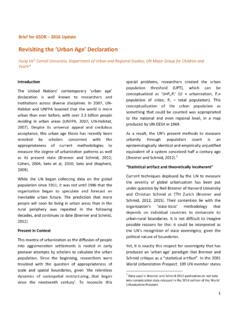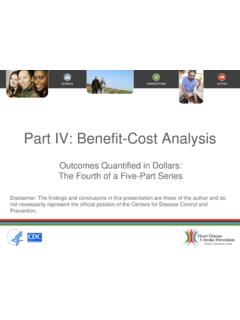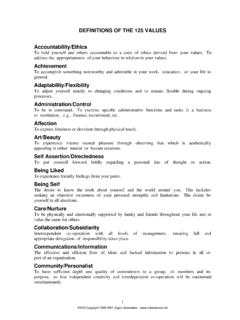Transcription of CONCLUSION - United Nations
1 Chapter 6. | CONCLUSION | 95 CONCLUSION6 CHAPTERThis concluding chapter highlights insights from the report that could contribute to strengthening the science-policy interface for sustainable development. The reader is referred to individual chapters and to the executive summary for a more comprehensive message comes across strongly from chapters 1, 2, 3 and 4, even though their topics are very different and the scientific communities involved around each of them are distinct: if no one is to be left behind in 2030, the notion of inclusiveness cannot be treated as an afterthought or even mainstreamed in other areas. Rather, it should be an integral part of institution design and functioning, of research and development, and of infrastructure planning and development, to mention only topics covered in this our understanding of the effectiveness of development strategies in leaving no one behindEnsuring that no one is left behind is a fundamental guiding principle for the implementation of the 2030 Agenda for Sustainable Development.
2 Science can inform decision-making on three broad questions. First, who are those being or at risk of being left behind? Second, how can strategies and policies reach them in practice? And third, what types of strategies and policies would be appropriate in order to leave no one behind? This report makes clear that many criteria are used in practice to identify those left behind, whether within a country or between countries. In practice, those left behind with respect to a particular dimension of the Agenda may be different groups in different societies. It is important to take into account the dynamic nature of deprivation and inequality; in this respect, preventive policies are critical to ensure that new people or group do not fall behind at the same time as others escape poverty and | Global Sustainable Development Report 2016In many areas, inclusive development strategies are the commonly accepted paradigm.
3 However, whether strategies succeed in reaching those left behind depend on many factors, from country-specific circumstances to their design, targeting methods and practical implementation. Available evaluations from different SDG areas all suggest that there are significant practical challenges in effectively reaching those left behind. Targeting, in and by itself, is not sufficient in order to leave no one behind development interventions, even if properly targeted, can result in at best partial solutions to deprivations and, as a result, only address part of the problem. Examples of interventions reviewed for the report that aim to reach the furthest behind first include: nutrition, where the core target of interventions in developing countries is those suffering the most from stunting; area-based interventions targeting the poorest locations; and strategies to provide shelter for homeless people.
4 Based on the limited evidence reviewed in the report, in many areas of the new Agenda, factoring in the imperative to leave no one behind in sustainable development interventions may not present insurmountable difficulties. Undertaking to systematically reach the furthest behind first may represent a much greater challenge and may in some cases imply a more significant departure from present strategies. Going forward, it will be important to systematically collect further scientific evidence on how existing development strategies do indeed reach the furthest behind. A first step could be an inventory of existing meta-studies that attempt to review the effectiveness of development interventions in different SDG areas in reaching those left behind.
5 While evaluations do exist for specific SDG areas, they use different criteria for defining and measuring those left behind or furthest behind and for assessing the effectiveness of interventions in reaching them. It could be worth assessing the costs and benefits of investing in more comparable frameworks for evaluating development interventions in different SDG areas. This would likely be a significant undertaking in terms of methodology and costs. Adopting an integrated approach to sustainable development: the infrastructure-inequality-resilience nexusThis year s report examines interlinkages between infrastructure, inequality and resilience. Extensive bodies of literature have focused on each of these areas.
6 For example, infrastructure has received significant attention in development circles, due to its perceived critical role in spurring economic growth and development. Yet, scientists focusing on each of those fields typically hail from different communities, making links between the three areas less commonly studied than any of the three areas taken in isolation. Among the possible interlinkages in the nexus, an extensive amount of scientific research was found on the links between infrastructure and inequality, as well as on how people s resilience is affected separately by infrastructure resilience and by inequality. Links from resilience to inequality and from resilience to infrastructure seem to have received less attention. Further research in this area may be needed to uncover important synergies and in any nexus, harnessing synergies and addressing trade-offs is critical for policy-making.
7 In this regard, the chapter illustrates the importance of adopting an integrated approach towards sustainable development. The research reviewed here emphasizes that a focus on both efficiency and equity is needed to harness the synergies between infrastructure, inequality and resilience. In this regard, contributing experts have noted that reducing inequalities in any of its dimensions also contributes to better infrastructure provision and increased resilience by, for example, increasing the likelihood of infrastructure investments that benefit vulnerable groups. An important policy component is geographic equity in the provision of basic infrastructure. The report provides examples of policies that have been found to address synergies in the nexus.
8 For example, labour-based programs in infrastructure projects can expand job opportunities and reduce inequalities, while at the same time improving resilience to natural disasters. Participatory processes that involve local communities and their various segments can be useful ways to ensure that considerations related to economic, social and environmental dimensions are taken into account when planning for infrastructure investment. Regulation and incentive mechanisms also need to be in place to integrate disaster risk reduction into all phases of the infrastructure life cycle, and to ensure the resilience of critical infrastructure to natural disasters. Contributing experts noted the need to further disaggregate the analysis between rural and urban contexts to be able to provide more specific policy recommendations.
9 Further cross-disciplinary collaboration and engagement between researchers, practitioners, decision makers and other stakeholders could be a way of achieving the mutual learning and transfer of information that would enable scientific knowledge to be transformed into practical strategies to harness the synergies and address the trade-offs between the three areas of the nexus. Mobilizing technology for the SDGs: scientists perspectivesThe report presents a range of perspectives of scientists on the role of technology for the achievement of the SDGs. Technology is essential for achieving the SDGs and reaping the benefits of synergies among them, as well as for minimizing trade-offs among goals. Technology, society and Chapter 6. | CONCLUSION | 97 institutions co-evolve. Hence, technology progress requires institutional adaptations and may be constrained by social issues.
10 Policy actions to achieve the SDGs and ensure that no one is left behind need to consider these interlinkages. Many scientists point to a need for making simultaneous progress on equity issues (especially technology access), on overall technology system performance, and on supporting institutional change - strategies focusing only on one of these components have proven ineffective in the long-run. Innovation systems, understood as the network of institutions in the public and private sectors whose activities and interactions initiate, import, modify and diffuse new technologies, perform sub-optimally if only one or the other of these elements is supported. Policy actions must support both research and development to spur technology performance at the technology frontier, as well as promote the diffusion and adaptation of existing technologies in developing countries and among marginalized groups in all countries one supports the other and vice versa.

